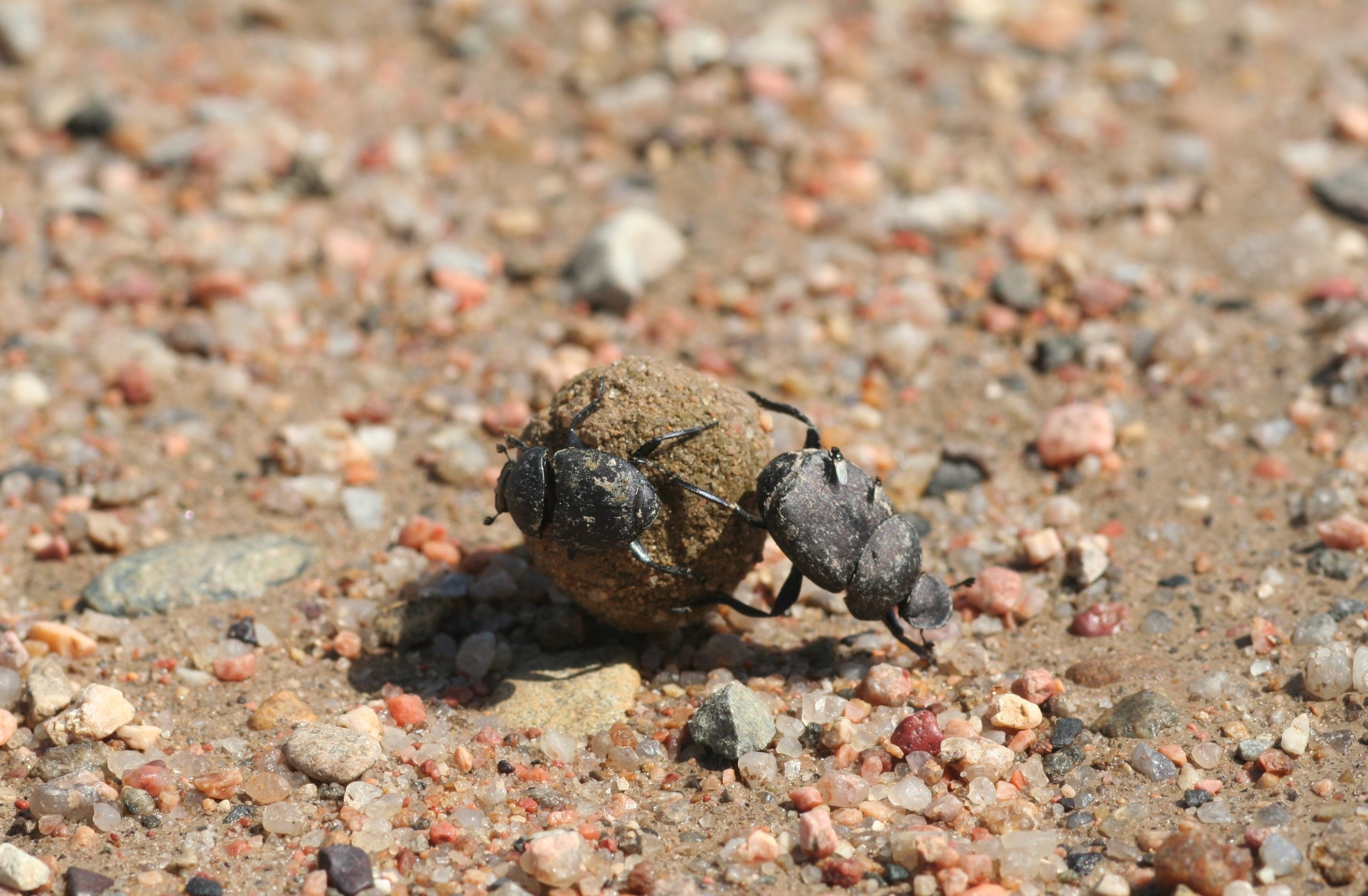
A pair of Canthon imitator beetles with a dung ball – the larger female pushes while the smaller male rides. This rolling behavior is shared with its close Florida relative, the common tumblebug (Canthon pilularius). Photo by Whitney Cranshaw, Colorado State University, Bugwood.org.
Dung Beetles of the Florida Panhandle
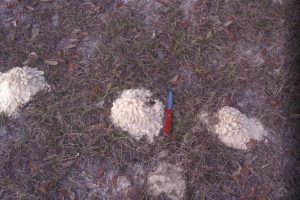
Mounds of excavated sand mark the tunnel entrances of Peltotrupes profundus in a scrubby Florida landscape. Photo by Lyle Buss.
There aren’t many creatures that can stir up a mix of admiration – and possibly some mild disgust – like the dung beetle. But if you spend much time around pastures, the woods, or even in your own garden, you might be surprised to learn these literal poop-pushers are the unsung heroes in local ecosystems – especially when it comes to soil health.
Dung beetles, which are primarily members of the Scarabaeidae family, specialize in feeding on and burying animal feces. That might not sound glamorous, but they more than earn their keep in the ecosystem. These beetles break down waste, aerate the soil, recycle nutrients, and reduce parasite loads in pastures. By quickly burying dung, they limit fly breeding and prevent harmful bacteria from hanging around longer than necessary.
In our part of Florida, where livestock, wildlife, and backyard chickens are common, dung beetles can play a quiet but essential role in keeping both landscapes and gardens healthier. While you might not see them directly in your raised beds, the soil health benefits they bring to the wider environment ripple out in ways gardeners can appreciate.
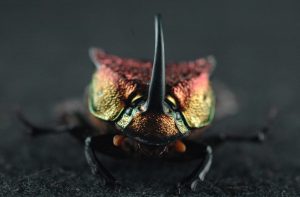
A male rainbow scarab (Phanaeus vindex) with the distinctive horn used in battles over dung. This native beetle is one of Florida’s most colorful nutrient recyclers. Photo by Joseph LaForest, University of Georgia, Bugwood.org.
Not all dung beetles are the ball-rolling athletes we imagine. In fact, most species in Florida are what we call tunnelers – they bury dung directly underneath where it lands, creating little underground pockets of fertility. Others are dwellers, who live inside the pile and lay their eggs right there.
While most of our local dung beetles are underground specialists, we do have at least one native species that performs that famous backward march. If you’re out walking after a summer rain, you just might spot a shiny black beetle with spiny legs rolling a dung ball twice its size – just one of the many native species quietly doing their part beneath our feet.
Native Dung Beetles of North Florida
While most people wouldn’t recognize a dung beetle if it landed on their compost pile, a surprising number of native species are hard at work across the Panhandle – from open fields to pine flatwoods to the edges of suburban backyards.
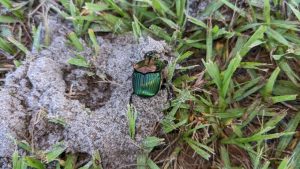
A female fiery scarab (Phanaeus igneus) emerges from a sandy tunnel in the Florida Panhandle. Photo by Erik Lovestrand, UF/IFAS.
One of the flashiest is the rainbow scarab (Phanaeus vindex), a heavy-bodied tunneler with a brilliant metallic sheen – often green or blue with coppery highlights. Males sport a single, curved horn and are known to spar over fresh dung like tiny armored knights. They’re most active in the warmer months and are common in both wild and grazed areas.
Another native jewel is the fiery scarab (Phanaeus igneus), which also shines with a coppery or red metallic glow. A Florida subspecies, P. igneus floridanus, occurs across central and northern parts of the state. These beetles prefer sandy soils and natural areas like longleaf pine uplands or scrub habitats, quietly tunneling through dung from wildlife or livestock.
And then there’s the Florida deepdigger scarab (Peltotrupes profundus), an endemic species found only in Florida. This dark, robust beetle creates conspicuous sand mounds in scrubby or pine-covered landscapes. Below those mounds? Tunnels that can run several feet deep. These beetles aren’t exclusive dung feeders – they mix organic matter into the soil, creating long-lasting soil channels that help roots breathe and water move more freely.

Adult Peltotrupes profundus, a Florida-endemic beetle known for its deep tunnels in sandy soils. Photo by Lyle Buss.
Finally, we have one native species that actually does roll its dung: the aptly named common tumblebug (Canthon pilularius). This smaller black beetle sculpts dung into neat balls and rolls them away to bury. They’re usually seen in open areas and pastures during the warmer seasons. If you spot one, enjoy the show – they’re fast, efficient, and usually gone in minutes.
Non-Native Dung Beetles in Florida
Several non-native dung beetle species have also become established in Florida, introduced in the 1970s to help manage cattle manure in pastures. These include species like the gazelle dung beetle (Digitonthophagus gazella), bull-headed dung beetle (Onthophagus taurus), and the sandy dung beetle (Euoniticellus intermedius). All three are tunnelers that quickly bury fresh dung, reducing fly populations and improving soil fertility. They’re now widespread in pastures across North Florida, especially in the summer and fall. Another common non-native is the European dung beetle (Aphodius fimetarius), a small red-and-black species that acts as a dweller, living and breeding directly within the dung pile itself.
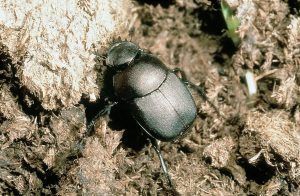
The common tumblebug (Canthon pilularius) is one of the few native dung beetles in Florida that rolls dung into balls. Photo by Kansas Department of Agriculture, Bugwood.org.
While none of these introduced beetles are currently considered invasive, some researchers have raised concerns about how they might compete with native species for dung – especially in heavily grazed pastures. That said, most tend to stick close to livestock areas and haven’t been shown to disrupt natural ecosystems in a meaningful way.
Soil Helpers, Garden Allies
For gardeners and farmers alike, dung beetles are some of our most efficient natural tillers. Their tunneling mixes organic matter deeper into the soil profile, improving structure and water infiltration. That means fewer compaction issues and better moisture retention during our dry spells. In pastures, studies have shown that they can improve grass growth and reduce runoff – pretty remarkable for something that lives in poop.
If you’re already focused on fostering a sustainable landscape, be sure to give dung beetles a spot on your list of wildlife to appreciate and protect. In a world full of tidy lawns and picture-perfect beds, dung beetles remind us that beauty isn’t always what you see on the surface. Sometimes, the real work is happening just below it.
- Cool Season Annual Herbs to Plant in December - December 11, 2025
- The Dirt on Compost: Hot and Worm Composting at Home - October 30, 2025
- Fall Gardening Spotlight: Collard Greens - October 3, 2025
